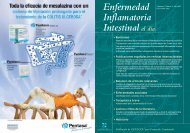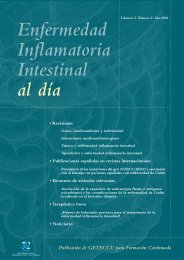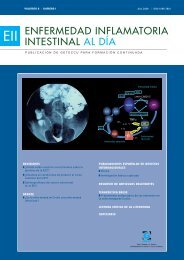Número 1 - EII al dÃa
Número 1 - EII al dÃa
Número 1 - EII al dÃa
Create successful ePaper yourself
Turn your PDF publications into a flip-book with our unique Google optimized e-Paper software.
pacientes que <strong>al</strong>canzaba la cicatrización de las lesiones<br />
mucosas fue significativamente superior. Todo ello sin<br />
diferencias en el número de efectos adversos graves<br />
entre ambos grupos. Aunque este es un estudio presentado<br />
únicamente como resumen, apoya la impresión<br />
gener<strong>al</strong> de la necesidad de adelantar la terapia<br />
con fármacos capaces de resolver las lesiones mucosas<br />
a fin de tener mayor posibilidad de <strong>al</strong>canzar remisiones<br />
prolongadas y reducir las complicaciones a largo<br />
plazo. Sin embargo, nuevos estudios deben confirmar<br />
la mejor evolución a largo plazo, en cuanto a la necesidad<br />
de cirugía, c<strong>al</strong>idad de vida y número de complicaciones<br />
cuando se administra terapia biológica y/o<br />
inmunosupresores de forma precoz.<br />
Los efectos con la nueva terapia biológica: ¿son<br />
más graves y/o frecuentes?<br />
El registro “TREAT” (21) v<strong>al</strong>ora la seguridad a largo<br />
plazo del anti-TNF mediante un estudio observacion<strong>al</strong>.<br />
En él se an<strong>al</strong>iza los datos de seguimiento en un<br />
grupo de 10.000 pacientes/año con EC comparando<br />
aquellos que recibieron anti-TNF respecto de los que<br />
no lo recibieron. La indicación del tratamiento se dejó<br />
a la consideración del médico del paciente. A pesar de<br />
que el grupo anti-TNF eran pacientes con enfermedad<br />
más grave y que habían requerido hospit<strong>al</strong>ización o<br />
recibido corticosteroides o inmunosupresores con<br />
mayor frecuencia en el año previo <strong>al</strong> estudio, la mort<strong>al</strong>idad<br />
fue similar entre ambos grupos y cuando la<br />
prednisona formó parte del tratamiento la mort<strong>al</strong>idad<br />
fue superior (RR = 2.10, 95% CI = 1.53-3.83). Ningún<br />
paciente desarrolló tuberculosis pulmonar y los factores<br />
que se asociaron de forma independiente con la<br />
presentación de infecciones graves fueron la administración<br />
de prednisona, el uso de narcóticos y las formas<br />
de EC moderada o grave. Además la incidencia de<br />
linfomas y neoplasias fue similar en ambos grupos.<br />
Este estudio muestra que el anti-TNF o los inmunosupresores<br />
no tienen un perfil de seguridad peor que los<br />
esteroides y por tanto su administración con conocimiento<br />
de sus efectos adversos puede re<strong>al</strong>izarse asumiendo<br />
un riesgo similar <strong>al</strong> de los fármacos inmunosupresores<br />
o la prednisona.<br />
En conclusión, en la actu<strong>al</strong>idad disponemos de datos<br />
que permiten presumir que el tratamiento con anti-<br />
TNF e inmunosupresores debe ser más precoz y, posiblemente,<br />
inici<strong>al</strong> en los pacientes en los que se prevea<br />
una evolución progresiva de la enfermedad. El objetivo<br />
sería conseguir la remisión clínica rápida, la cicatrización<br />
de las lesiones mucosas y la prevención de las<br />
complicaciones a largo plazo, es decir un cambio positivo<br />
en la historia natur<strong>al</strong> de la EC.<br />
BIBLIOGRAFÍA<br />
1. Farmer RG, Hawk WA, Turnbull RB Jr. Clinic<strong>al</strong> patterns in Crohn's disease:<br />
a statistic<strong>al</strong> study of 615 cases. Gastroenterology. 1975;68:627-35.<br />
2. Munkholm P, Langholz E, Davidsen M, Binder V.Disease activity courses in<br />
a region<strong>al</strong> cohort of Crohn's disease patients. Scand J Gastroenterol.<br />
1995;30: 699-706.<br />
3. Munkholm P Langholz E, Davidsen M, Binder V. Intestin<strong>al</strong> cancer risk and<br />
mort<strong>al</strong>ity in patients with Crohn's disease. Gastroenterology 1993;<br />
105:1716-1723.<br />
4. Sands BE, Arsenault JE, Rosen MJ, Alsahli M, Bailen L, Banks P, Bensen S,<br />
Bousvaros A, Cave D, Cooley JS, Cooper HL, Edwards ST, Farrell RJ, Griffin<br />
MJ, Hay DW, John A, Lidofsky S, Olans LB, Peppercorn MA, Rothstein RI,<br />
Roy MA, S<strong>al</strong>etta MJ, Shah SA, Warner AS, Wolf JL, Vecchio J, Winter HS,<br />
Zawacki JK. Risk of early surgery for Crohn's disease: implications for<br />
early treatment strategies. Am J Gastroenterol 2003; 98:2712-2716<br />
5. Rutgeerts P Geboes K, Vantrappen G, Beyls J, Kerremans R, Hiele M.<br />
Predictability of the postoperative course of Crohn's disease.<br />
Gastroenterology 1990; 99:956-963.<br />
6. Binder V, Hendriksen C, Kreiner S.Prognosis in Crohn's disease--based on<br />
results from a region<strong>al</strong> patient group from the county of Copenhagen.<br />
Gut. 1985; 26:146-50.<br />
7. Gregor JC. Utility Estimates for Chronic Diseases. Inflammatory Bowel Dis<br />
1997; 3:265.<br />
8. Vasiliauskas EA, Kam LY, Karp LC, Gaiennie J, Yang H, Targan SR. Marker<br />
antibody expression stratifies Crohn's disease into immunologic<strong>al</strong>ly<br />
homogeneous subgroups with distinct clinic<strong>al</strong> characteristics. Gut 2000;<br />
47:487-96.<br />
9. Arnott ID, Landers CJ, Nimmo EJ, Drummond HE, Smith BK, Targan SR,<br />
Satsangi J. Sero-reactivity to microbi<strong>al</strong> components in Crohn's disease is<br />
associated with disease severity and progression, but not NOD2/CARD15<br />
genotype. Am J Gastroenterol. 2004;99:2376-84.<br />
10. Kugathasan S, Collins N, Maresso K, Hoffmann RG, Stephens M, Werlin<br />
SL, Rudolph C, Broeckel U. CARD15 gene mutations and risk for early<br />
surgery in pediatric-onset Crohn's disease. Clin Gastroenterol Hepatol.<br />
2004;2:1003-9.<br />
11. Olaison G, Smedh K, Sjodahl R. Natur<strong>al</strong> course of Crohn's disease after<br />
ileocolic resection: endoscopic<strong>al</strong>ly visu<strong>al</strong>ised ile<strong>al</strong> ulcers preceding<br />
symptoms. Gut. 1992;33:331-5.<br />
12. Modigliani R, Mary JY, Simon JF, Cortot A, Soule JC, Gendre JP, Rene E.<br />
Clinic<strong>al</strong>, biologic<strong>al</strong>, and endoscopic picture of attacks of Crohn's disease.<br />
Evolution on prednisolone. Groupe d'Etude Therapeutique des Affections<br />
Inflammatoires Digestives. Gastroenterology. 1990;98:811-8.<br />
13. D'Haens G, Geboes K, Rutgeerts P. Endoscopic and histologic he<strong>al</strong>ing of<br />
Crohn's (ileo-) colitis with azathioprine. Gastrointest Endosc.<br />
1999;50:667-71.<br />
14. Panaccione R. Methotrexate" "lessons from rheumatology".Can J<br />
Gastroenterol. 2005;19:541-2.<br />
15. Rutgeerts P, Feagan BG, Lichtenstein GR, Mayer LF, Schreiber S, Colombel<br />
JF,Rachmilewitz D, Wolf DC, Olson A, Bao W, Hanauer SB. Comparison<br />
of scheduled and episodic treatment strategies of infliximab in Crohn's<br />
disease. Gastroenterology. 2004;126:402-13.<br />
16. Lichtenstein GR, Yan S, B<strong>al</strong>a M, Blank M, Sands BE.Infliximab maintenance<br />
treatment reduces hospit<strong>al</strong>izations, surgeries, and procedures in fistulizing<br />
Crohn's disease. Gastroenterology. 2005;128:862-9.<br />
17. Quinn MA, Conaghan PG, O'Connor PJ, Karim Z, Greenstein A, Brown A,<br />
Brown C, Fraser A, Jarret S, Emery P. Very early treatment with infliximab<br />
in addition to methotrexate in early, poor-prognosis rheumatoid arthritis<br />
reduces magnetic resonance imaging evidence of synovitis and damage,<br />
18 • Enfermedad Inflamatoria Intestin<strong>al</strong> <strong>al</strong> día - Vol. 5 - Nº. 1 - 2006











